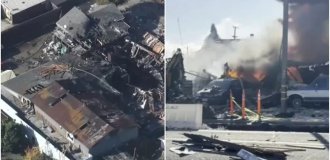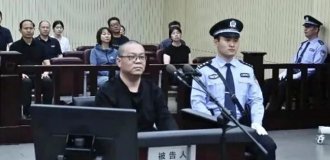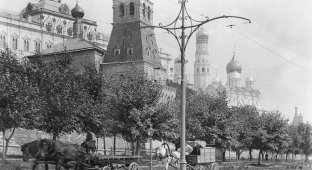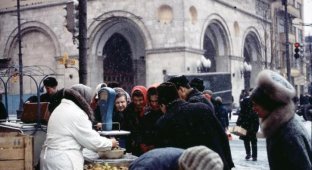Photos of the same places in Moscow after tens, or even hundreds of years. It's interesting to see how the streets and buildings have changed over time.
Pokrovka


View of the Pashkov House, st. Mokhovaya and Znamenka.
On the left in both photographs you can see the turn into Lebyazhy Lane:


Kuznetsky Most street
In the foreground of an old photograph is the famous “Khomyakova Grove” (story below):


And here is the story of "Hamster Grove":
The young businessman Khomyakov inherited a huge plot of land near Petrovka, the border
which contradicted the plan for future urban development: part of the Khomyakov estates
Moscow authorities wanted to buy it in order to expand Kuznetsky Lane. Khomyakov replied that
he has his own plans for this land, he fenced the area with a cast-iron fence, laid out a “stunted” area there
kindergarten To the chief police chief’s threat to expel him from Moscow within 24 hours, the landowner replied:
“You can evict me. I will leave, but my property will remain.” As a result, in the middle
On Kuznetsky Lane, a small triangular garden, nicknamed
Muscovites Khomyakovskaya Grove. He destroyed it, according to Gilyarovsky, in a dispute with his
editor-in-chief journalist of "Entertainment" Pazukhin: he sent Khomyakov proofs of the cartoon
- a donkey with the face of Khomyakov, walking in the grove. The next morning the greenery and the lattice had disappeared.
st. Maroseyka:


Alexander Garden:


Lubyanskaya Square


Krestovskaya Zastava (Rizhsky Station Square)


The water towers of the Mytishchi water supply system were built in 1892.
In each of the Krestovsky towers, at a height of thirty meters from the ground, there was a reservoir for 150 thousand buckets (1900 m3).
From here, water flowed through cast-iron conduits to the city center.
The towers were demolished in 1940.
Znamenka street (on the left is Pashkov’s house)


Moskvoretskaya street


Moskvoretskaya street between Varvarka street and Moskvoretskaya embankment, parallel
Vasilievsky descent. In the XIV century. connected the settlement with the piers on the Moscow River. In 1634–38 her
cut the wall of Kitay-Gorod with the Moskvoretsky Gate to access the river. In the 17th century Street
began at the Spassky Gate of the Kremlin, passed through Red Square (between St. Basil's Cathedral
Blessed and Execution Place) to Varvarka, then changed direction and went to the river. On
Moskvoretskaya Street from the Zaryadye side has been built since the end of the 15th century. Mytny Dvor was located, and with it
Animal area, where taxes were collected from livestock, poultry, sleighs, carts, etc. In the shops
Mytny Dvor sold meat. At the end of the 18th century. a project for “settlement” of Moskvoretskaya emerged
streets with the destruction of buildings near its intersection with Varvarka. As a result, the street became
shorter and straighter. On both sides there were two-story houses with shops in the first
floors; from the side of Zaryadye the building front was interrupted by the large facade of Mytny Dvor (end
XVIII century, architects S.A. Karin, I.A. Selekhov), and from the side of Red Square - a church
Nikola Moskvoretsky (known since the 16th-17th centuries; rebuilt in 1829-32). In the 1930s
almost the entire building of the street was destroyed due to the construction of the new Moskvoretsky
bridge; the remaining buildings were demolished in the 1960s. during the construction of the Rossiya Hotel. Nowadays
Moskvoretskaya Street does not have a single house, it is a passage limited by a lawn
in front of the Rossiya Hotel and the exit to the bridge.
Tverskaya Zastava Square. Triumphal Arch.


Initially it was located in the center of Tverskaya Zastava Square (Belorussky Station Square), where
the road to St. Petersburg began; together with the guardhouses adjacent to the sides, designed
ceremonial entry into the city. The stone single-span Arc de Triomphe, 28 m high, was
erected in 1827–34 according to the design of O.I. Beauvais on the site of a wooden one built in 1814 for
solemn meeting of Russian troops returning from Western Europe after the victory over
French Emperor Napoleon I. Special solemnity and at the same time subtle
decorative expressiveness was given to the monumental, plastic forms of the arch in the Empire style
numerous cast iron details of its decoration, including 6 pairs of twelve-meter
columns, statues of Russian soldiers placed between them, high reliefs “Expulsion of the French”,
“Liberation of Moscow” and others, above the cornice are allegorical figures of Victory and the crowning arch
chariot of Glory (all sculptures are the work of I.P. Vitali). In 1936 the gates were demolished, and part
sculptural decoration was transferred to the Museum of Architecture. In 1966 - 1968 the Arc de Triomphe was
recreated in a new place - at Poklonnaya Gora, near the Battle of Borodino Panorama Museum. For
monolithic reinforced concrete was used for construction, the white marble cladding of the plinth was
replaced by granite, the walls are lined with blocks of Crimean limestone, all missing
sculptural details, as well as twelve-meter columns were again cast from cast iron (authors
project V.Ya. Libson, D.I. Kulchinsky, N.N. Sobolev; sculptor V.V. Glebov).
Okhotny Ryad


Okhotny Ryad (former Okhotnoryadskaya Square, in 1933–55 Okhotny Ryad Square, in 1961–90 part
Marx Avenue), a street between Manezhnaya Square and Teatralnaya Square. Continuation of Mokhovaya
street, turns into Teatralny Proezd. It was inhabited already in the 15th century; in 1406 a church is mentioned
Paraskeva Pyatnitsa, in 1458 - Church of Anastasia (opposite Bolshaya Dmitrovka Street). At the end of XV
V. the street was crossed by the road to Novgorod, running from Red Square along Tverskaya Street, which
led to the establishment of inns and forges here. Since 1565 due to proximity
Nobles began to settle in the oprichnina courtyard on the northern side of the street (now an even numbered one). In the 17th century
here were the courts of Prince Dolgorukov, the Volynsky boyars, V.V. Golitsyn with stone chambers
palace type; At the expense of Golitsyn, the Church of Paraskeva Pyatnitsa (XVII century) was built.
The other side was occupied by shopping arcades located along the street parallel to the river bed.
Neglinnaya: Malt, Zhitny and Flour. In 1737, the rows burned down and part of the vacated territory was allocated for the location of Okhotny Ryad (shops where they sold beaten poultry), previously located near Mokhovaya Street, on modern Manezhnaya Square. On the site opposite Tverskaya Street, a new state-owned Mint was built (since 1742, the Berg Collegium was located in its building). According to the plan of 1775, a square was to be formed in Okhotny Ryad, to create which the Church of Anastasia and a number of other buildings were demolished in 1793; the shops were moved to the south side of the square. On the north side, on the corner of Bolshaya Dmitrovka, in 1784-87 the house of Prince V.M. was rebuilt for the Noble Assembly. Dolgorukov-Krymsky (house 2, architect M.F. Kazakov).
In 1812, the wooden shops burned down and were replaced by stone shopping arcades. In the 19th century The Okhotny Ryad area acquired an exclusively commercial character: shops, warehouses, hotels, taverns, etc. were located there. In 1930 Okhotny Ryad was reconstructed, almost all of the old buildings, including the Golitsyn Chambers and the Paraskeva Church, were demolished, and in this place - the Moscow Hotel (building 7; 1935, architects O.A. Stapran, A.V. Shchusev and etc.; second stage - 1977, architects A.B. Boretsky, D.S. Solopov, I.N. Rozhin) and the Building of the Council of Labor and Defense (building 12, 1933-36, architect A.Ya. Langman, now State Duma building). Part of Okhotny Ryad disappeared due to the formation of Manezhnaya Square. From the north side, Tverskaya and Bolshaya Dmitrovka streets overlook the street.
View of the National Hotel from Okhotny Ryad.


Opened at the beginning of the 20th century, the National has become one of the most modern hotels in its
time. During its construction, advanced technologies were used - it was equipped
elevators and telephones, mechanical ventilation systems and water closets. After
Revolution "National" became the first House of Soviets, since 1918 V.I. Lenin lived here with
wife. Gradually the hotel turned into a hostel for the party nomenklatura and became
fall into decay. In the thirties of the last century, the hotel was renovated, furnishing
interior items from disbanded estates and palaces. During the Second World War here
foreign embassies and diplomatic missions were located. Conducted within the walls of the hotel
negotiations between Joseph Stalin and Winston Churchill. The newest history of National began with the opening
hotel after a four-year renovation in 1995.
"National" is recognized as a monument of history and architecture. During the reconstruction of the facade and
the interior of the building was restored to its original appearance, and modern engineering communications were
laid in such a way as not to cause damage to the building. Under many layers of paint were revealed
paintings from the beginning of the last century, stucco and frescoes. Now they decorate the most expensive rooms
hotel. The interiors of “National” feature more than 400 original antiques.
Belorussky railway station


Barbarian Gate


The Kitay-Gorod wall and the tower with the Varvarsky Gate were built in the 30s. XVI century
The barbarian tower, standing on a break in the wall above a steep slope,
was one of the most powerful in the Kitaygorod fortifications.
In plan, it resembled the Kutafya tower of the Kremlin.
The tower was pushed far forward, and deep underground chambers were made under it - “rumors” to combat enemy mines.
Decorative parapet, tetrahedral tent and windows in the upper tier
(between the loopholes) were built in the 17th century and distorted the simple monolithic architecture of the tower, which finds direct analogies in Italian treatises on fortification of the 15th-16th centuries.
The tower with rare machicolations* was originally a travel pass, and the passage through it for defense purposes was arranged “with a twist.”
The original gate is visible on the side of the tower on the right (Above them is a large icon case).
The wide arch of the breach gate, built directly into the wall, is a later one.
The tower was demolished in 1934.
At the same time, the entire wall was completely demolished, with the exception of the curtains in Kitaygorodsky Proezd
and on Revolution Square.
Solyanka
Church of the Nativity of St. Our Lady of Strelka


On Solyanka Street, at the fork with Podkolokolny Lane, there is the Church of the Nativity of the Blessed Virgin Mary on Kulishki (on Strelka).
The first temple on this site has been known since 1547, the stone one was built around 1600. Here too
you can remember the heroes of the Battle of Kulikovo, because on the slopes of Alabova Mountain, where it stands
temple, they also buried those who fell on the Kulikovo Field. The current temple was built in 1801–1821
gg. with the inclusion of parts of an ancient temple of the 18th century. After the closure of the temple in 1930, the building was
occupied by an administrative office, the domes and bell tower have been dismantled.
Now the temple has been returned to the Church and is being restored.
The service in the church has a peculiarity - it is performed in Alanian and Church Slavonic
languages.
So the residents of North Ossetia-Alania (the Alans were baptized back in the 4th century)
have the opportunity to pray in their native language.
Vasilyevsky Spusk


Vasilyevsky Spusk travel along the Kremlin wall from Red Square to the Kremlin embankment. Named after St. Basil's Cathedral (Cathedral of the Intercession on the Moat). Vasilievsky Descent was formed as a result of the reconstruction of Red Square after the fire of 1812, when the ditch was filled in, the diversion arch of the Konstantin-Eleninsky Gate of the Kremlin was demolished, the descent was cleared and leveled, but the buildings from the Cathedral of the Intercession on the Ditch to the bank of the Moscow River were preserved.
In 1909, tram tracks were laid along Vasilyevsky Spusk.
In 1936, in connection with the construction of the new Moskvoretsky Bridge, all buildings on Vasilyevsky Spusk were destroyed, and it became a transport passage.
Lubyanskaya Square (view from Nikolskaya Street)


Arbat Square


View of the Cathedral of Christ the Savior


Christ the Savior Cathedral in Moscow, built in 1837–83 on the site of the former Alekseevsky Monastery
according to the project by K.A. Tona (1832) as a temple-monument dedicated to the Patriotic War of 1812.
Built in the so-called Russian-Byzantine style, grandiose in scale (height 103.3 m)
the building was distinguished by the luxury of its external and internal decoration (sculptures by P.K. Klodt, A.V.
Loganovsky, N.A. Ramazanova, F.P. Tolstoy, painting by V.V. Vereshchagina, K.E. Makovsky, V.I.
Surikov and others).
Blown up on December 5, 1931.
Until 1993, the Moscow swimming pool existed in its place.
In 1995, work began on the reconstruction of the temple.
On August 19, 2000, His Holiness Patriarch Alexy II performed the Great Consecration of the Cathedral of Christ the Savior.
Taganskaya Square


Old craft and shopping district of Moscow.
The square got its name from the Tagansky Gate in the wall of the earthen city, and the gate, in
in turn, along the Taganskaya Sloboda, where artisans lived who forged cast iron tripods
for camp kitchen boilers - tagans.
Since the 17th century There was an import market outside the T. gate. At the end of the 18th century. and after the fire of 1812
Taganskaya Square was reconstructed.
From the end of the 18th century. built up with stone benches.
In 1813, shopping arcades were erected here (architect O.I. Bove).
In 1950, the entrance hall of the station was built. Taganskaya metro station (architects A.A. Medvedev and K.S. Ryshkov)
In the early 1960s. A transport tunnel has been built under Taganskaya Square. In the 1970s reconstructed.
During reconstruction, shopping arcades and most of the old buildings were dismantled.
Manege


Built in 1817, for the 5th anniversary of the victory over Napoleon.
Construction lasted 6 months and was completed on the day of the military parade in the presence of
Emperor Alexander I.
The project was developed by engineer A.A. Betancourt, the work was supervised by engineers A.L. Carbonnier and
AND I. Kashperov.
To cover the building (45 m wide), a unique unsupported structure was developed from
wooden farms.
Contemporaries wrote that the arena building “in its enormity, architecture and roof structure has no
nothing like it in Europe"
There are cases when foreign engineers came to study the arena floor system.
In 1825, the architect O.I. Beauvais developed a façade decor project. He gave the building a modern look.
The integrity of the appearance of the building is due to the laconicism and uniformity of large architectural details. The measured rhythm of the long facades (over 166 m) is created by an arcade of window openings separated by three-quarter Tuscan columns and a heavy entablature including relief inserts. Initially, an entrance semi-rotunda (lost) was placed along the axis of the facade facing the Alexander Garden. The high gable roof is visually lightened by frequently installed dormer windows and smooth, undecorated gables at the ends of the building. The very significant urban planning role of the Manege, which forms two streets, increased even more with the formation of the huge space of Manege Square.
View of the Metropol and the Great Moscow Hotel


Golofteyevsky passage.
Trading house "Mur and Mereliz"


The shopping gallery building (on the left, a small building) was built in the 1840s by Prince Mikhail Golitsyn. Later, the gallery was bought by the merchant Golovteev. At the beginning of the 20th century, Golovteevsky and neighboring Aleksandrovsky passages (a large building that has survived to this day) became part of the commercial and industrial partnership "Mur and Mereliz".
The partnership "Mur and Mereliz" was founded in St. Petersburg in 1843 by the Scotsman Mereliz (Meriliz) Archibalz. Mereliza's successor, his wife's brother, Scotsman Andrew Muir (from 1867 a Moscow merchant of the 1st guild), opened a branch of the company in Moscow, initially in the form of a trading house (in 1907 it was transformed into a partnership). From 1878 he rented, in 1885 he bought a three-story building on Teatralnaya Square, where he opened a ladies' hat and haberdashery store next to the wholesale trade department.
In 1974, the Golovteevsky Passage building was demolished and the modern TSUM building was built in its place.
Manezhnaya Square


Patriarch's Ponds


The Patriarchal Pond known to us is the third of the three Patriarchal Ponds that existed here before the beginning of the 19th century. These three ponds were located in the patriarch's estate on the Goat Swamp (in the area of Malaya Bronnaya Street and Maly Kozikhinsky Lane).
The memory of the Three Patriarch's Ponds is preserved in the name of Trekhprudny Lane.
The surviving third pond, which was called Pionersky in 1932–92, has an area of 0.99 hectares. The average depth is 2 m. Power comes from ground and surface water, as well as from the water supply. The banks are reinforced with reinforced concrete slabs. Used as a resting place; in winter there is a skating rink.
The Patriarch's Ponds are known as the setting of the novel by M.A. Bulgakov "The Master and Margarita".
In the park on the Patriarch's Ponds (area about 3 hectares), a monument to I.A. was erected in 1976. Krylov (sculptors A.A. Drevin, D.Yu. Mitlyansky, architect A.G. Chaltykyan). In 2003, the Moscow authorities decided to perpetuate the memory of M. Bulgakov by installing a composition by the sculptor Rukavishnikov on Patriki (Moscow, “diminutive” name for the pond). Perhaps not a single architectural project in the capital in recent years has caused such a resonance in society as the reconstruction of the Patriarch's Ponds. Its initial version with the installation of the entire multi-figure composition dedicated to Mikhail Bulgakov and the heroes of the novel “The Master and Margarita” did not suit the residents. They protested especially sharply against the installation of a giant primus stove over the surface of the water. As a result of numerous protests, construction of the monument was stopped.
The pond and embankment were reconstructed, and the park area was landscaped.
Ostozhenka


From 1935 to 1986 the street was called Metrostroevskaya (in honor of the creation of the first stage of the metro).
In the XIV century. in the area of the street there was the palace village of Semchinskoye and the Alekseevsky nunnery.
The territory near the Moscow River was occupied by mowing fields - “ostozhie” (hence the name).
In 1612, D.M.’s camp was located on Ostozhenka. Pozharsky.
In the XVII-XVIII centuries. Some of the plots near Ostozhenka passed into the hands of nobles, whose names are associated with the names of some lanes adjacent to Ostozhenka (Vsevolzhsky, Eropkinsky, Lopukhinsky, Khilkov).
In house 37 in the 40s and 50s. XIX century stopped by I.S. Turgenev (gray house with columns on the right in the photo).
In 1933–35, construction of the first metro line was underway on the street.
In 1960 Ostozhenka was connected by Komsomolsky Prospekt (an overpass across the Garden Ring) with
southwest of the city.
Vasilyevsky Spusk
Old building of the Upper Trading Rows


An old photograph by Gautier-Dufayer shows the Old Upper City shopping arcades built by the architect O.I. Beauvais after the fire of 1812.
“The old city rows were dark ruins. The passages in them were not clean, there were many steps and various steps; one could only walk along such rows with great caution.” From the memoirs of the merchant I.A. Slonov.
Sukharevskaya Square


The name of the square (In fact, there are two squares - Small and Large) - from the Sukharev Tower, erected at the end of the 17th - beginning of the 18th centuries (In 1934, under the pretext of the need to expand the Garden Ring, the tower was demolished). In the 17th century in the area of modern Sukharevskaya Square there was one of the Streletsky settlements; at the end of the 17th century. there was a regiment of L.P. in it. Sukharev, who guarded the gates of Zemlyanoy City. Since the 18th century here and in nearby alleys the Sukharevsky market (Sukharevka) was located - one of the most crowded in Moscow; It sold not only food products, but also old and antique things - manuscripts, books, paintings.
1930s and 1970s Reconstruction was carried out on Sukharevskaya Square.
In the 1970s At the intersection of Sukharevsky Square and Sretenka Street, two public gardens have been laid out on the site of old houses.
In 1972, the Kolkhoznaya metro station (now Sukharevskaya) was opened.
Kudrinskaya Square


Teatralny Proezd


Arbat Square


House of Unions


Fountain on Teatralnaya Square (formerly Sverdlov Square)


Bolshaya Yakimanka street


Strastnaya Square
Temple of Demetrius of Thessalonica


Pokrovka Street

Bolshaya Bronnaya Street
View towards Pushkin Square


Bolshoi Zlatoustinsky Lane
View from Maroseyka street


Middle Kislovsky Lane
View towards Bolshoi Kislovsky Lane


Tverskaya Square
View of the Tverskoy police house


Bolshoi Kislovsky Lane
View towards B. Nikitskaya street
View of Sredny Kislovsky Lane from Bolshoi Kislovsky Lane.
Corner of Bolshoi Kislovsky Lane and Bolshaya Nikitskaya Street


Omona Theater on Triumphal Square


Lubyanskaya Square


Teatralny Proezd
View towards Lubyanka Square.
Building of the "Children's World" store, FSB building


Theater Passage arose in the 15th century, when the river that crossed it. A wooden bridge was thrown across Neglinnaya. From 1961 to 1990, part of Marx Avenue. The building of the "Children's World" store was built in 1955-57 (architect A.N. Dushkin and others). The building of the Rossiya insurance company (in the old photograph) was erected in 1897-1898 according to the design of academician A.V. Ivanova. Initially, it was an apartment building that was considered elite.
Apartments in this building were two or even three times more expensive than in other parts of Moscow.
On the ground floor of the building there were: Naumov's bookstore, Popov's sewing machine store, Yarnushkevich's bed store, Vasilyeva and Voronin's beer shop and many others.
Restaurant "Prague"


The restaurant building was built at the beginning of the 19th century. At first it was an ordinary apartment building. Then a tavern called "Prague" was opened here. The tavern's visitors were ordinary people, mostly cab drivers, since there was a cab driver's stop on Arbat Square. They changed the name of the tavern from “Prague” to “Braga”. Probably, “Prague-Braga” would have disappeared like many other Moscow taverns, if in 1896 the merchant Pyotr Semenovich Tararykin had not won the establishment along with the building at billiards. Tararykin immediately realized that the most valuable thing about “Prague” was its ideal location at the junction of such prestigious streets as Arbat and Povarskaya, plus the busy Boulevard Ring and the square. The new owner energetically set to work, turning a provincial tavern into a first-class restaurant for the “clean” public. He built on and expanded the building, and in 1914 he built something like a summer garden on the roof, decorated numerous halls and offices with wall paintings, mirrors, stucco and bronze.
The best gypsy ensembles and famous performers began to be invited to the restaurant.
Sveshnikov Lane
View towards Shvivaya Hill


Sveshnikov Lane went in ancient times from the mouth of the Yauza to Shvivaya Gorka Lane.
When adjusting the banks of the Yauza, it was cut off from it by a narrow block along the Podgorskaya (Ostrovnaya) embankment. Sewing slide. This colorful Moscow name comes, perhaps, from the word “ushivaya”, that is, overgrown with ear - prickly grass, sometimes in popular speech it was replaced by an even more colorful one - Lousy hill. These places were very loved by Muscovites; from here they had a beautiful view of the bend of the Moscow River, Zaryadye and the Kremlin. Here, on Shvivaya Gorka, one of the creators of post-fire Moscow, the architect O. Bove, intended to build a temple-monument to the Patriotic War of 1812.























